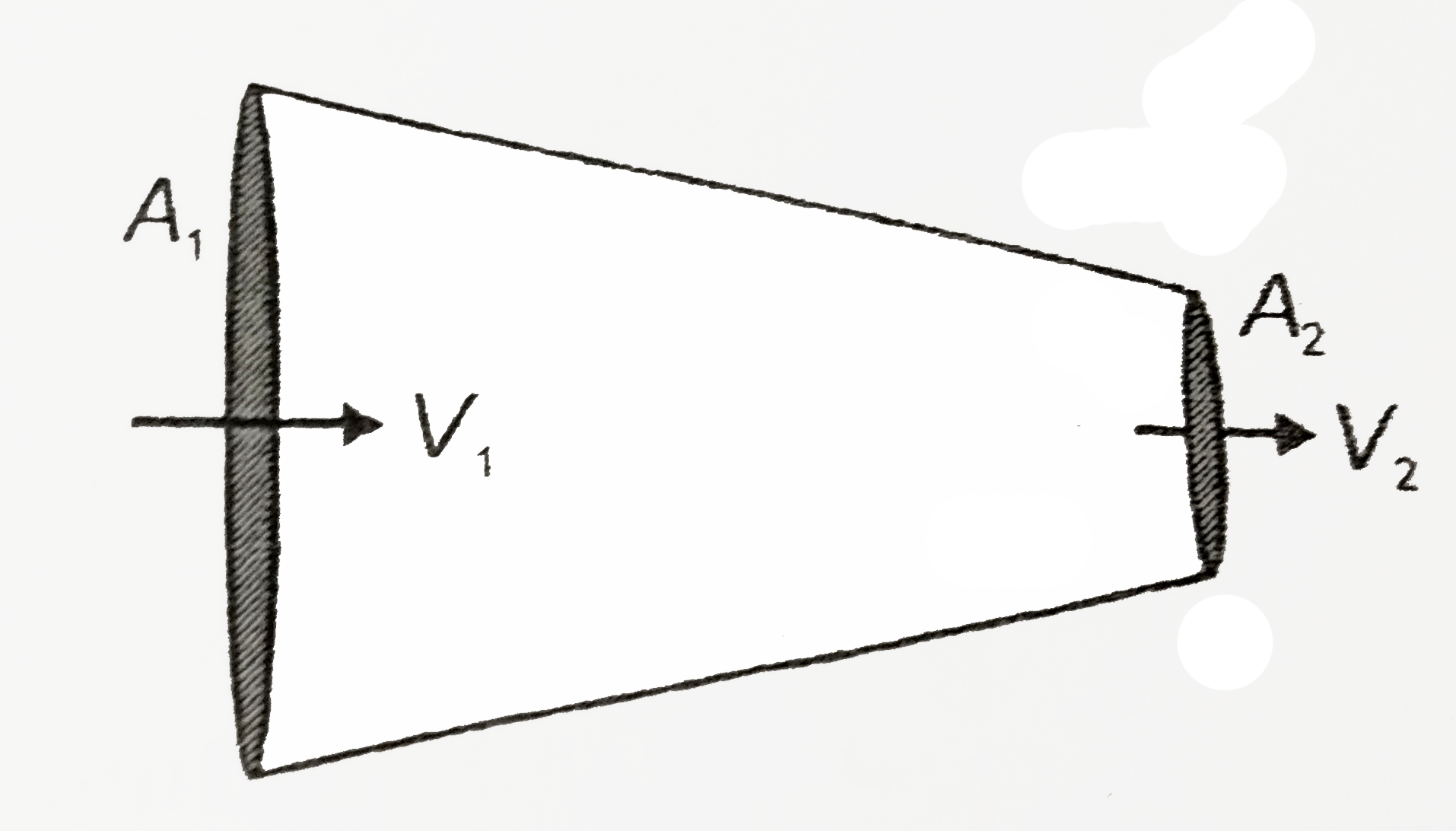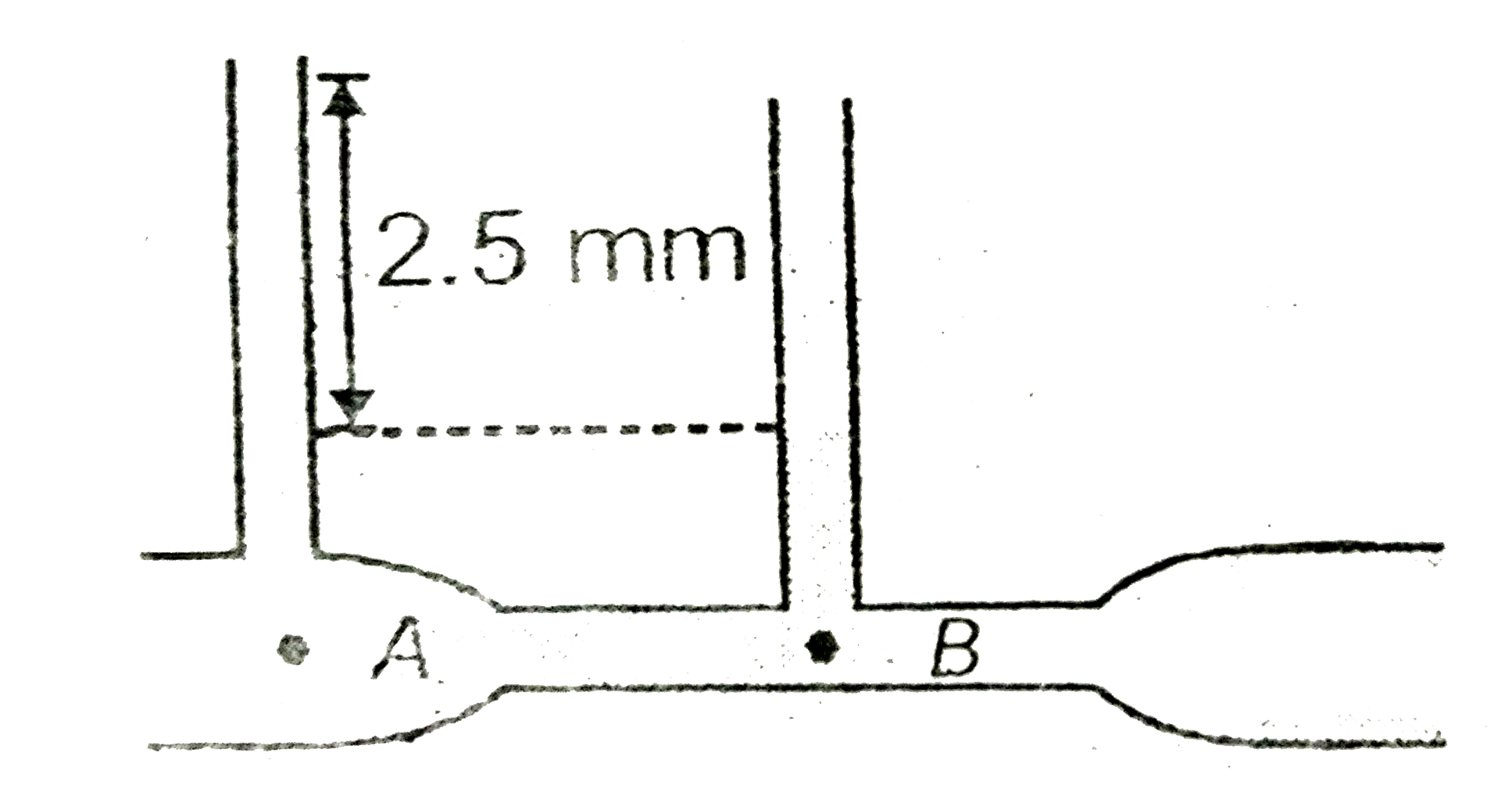Calculate the rate of flow of glycerine of density 1.25×103kg/m3 through the conical section of a pipe if the radii of its ends are 0.1m and 0.04 m and the pressure drop across its lengths is 10N/m2.
The correct Answer is:[6.44×10−4m3/s]
To solve the problem of calculating the rate of flow of glycerine through a conical section of a pipe, we will follow these steps:
Step 1: Identify the given data
- Density of glycerine, ρ=1.25×103kg/m3
- Radius at end 1, r1=0.1m
- Radius at end 2, r2=0.04m
- Pressure drop, ΔP=10N/m2
Step 2: Calculate the cross-sectional areas
The cross-sectional area A of a circle is given by the formula:
A=πr2
- For end 1:
A1=π(0.1)2=π×0.01=0.0314m2
- For end 2:
A2=π(0.04)2=π×0.0016=0.00503m2
Step 3: Use the continuity equation
According to the continuity equation:
A1v1=A2v2
We can express v2 in terms of v1:
v2=A1A2v1
Step 4: Apply Bernoulli's equation
For incompressible flow, Bernoulli’s equation can be simplified to:
ΔP=12ρ(v22−v21)
Substituting v2:
ΔP=12ρ((A1A2v1)2−v21)
Step 5: Rearranging the equation
Rearranging gives:
ΔP=12ρ(A21A22v21−v21)
ΔP=12ρv21(A21A22−1)
Step 6: Solve for v1
Rearranging for v1:
v21=2ΔPρ(A21A22−1)
v1=
⎷2ΔPρ(A21A22−1)
Step 7: Calculate A21A22
Calculating:
A21A22=(0.03140.00503)2≈39.4
Step 8: Substitute values into v1
Substituting values:
v1=√2×101.25×103×(39.4−1)
v1=√201.25×103×38.4≈√2048000≈√0.00041667≈0.0204m/s
Step 9: Calculate the volumetric flow rate Q
Using the formula:
Q=A1v1
Q=0.0314×0.0204≈0.00064056m3/s≈6.4×10−4m3/s
Final Result
The rate of flow of glycerine through the conical section of the pipe is approximately:
Q≈6.44×10−4m3/s
- Density of glycerine, ρ=1.25×103kg/m3
- Radius at end 1, r1=0.1m
- Radius at end 2, r2=0.04m
- Pressure drop, ΔP=10N/m2
The cross-sectional area A of a circle is given by the formula:
A=πr2
- For end 1:
A1=π(0.1)2=π×0.01=0.0314m2
- For end 2:
A2=π(0.04)2=π×0.0016=0.00503m2
According to the continuity equation:
A1v1=A2v2
We can express v2 in terms of v1:
v2=A1A2v1
For incompressible flow, Bernoulli’s equation can be simplified to:
ΔP=12ρ(v22−v21)
Substituting v2:
ΔP=12ρ((A1A2v1)2−v21)
Rearranging gives:
ΔP=12ρ(A21A22v21−v21)
ΔP=12ρv21(A21A22−1)
Rearranging for v1:
v21=2ΔPρ(A21A22−1)
v1=
⎷2ΔPρ(A21A22−1)
Calculating:
A21A22=(0.03140.00503)2≈39.4
Substituting values:
v1=√2×101.25×103×(39.4−1)
v1=√201.25×103×38.4≈√2048000≈√0.00041667≈0.0204m/s
Using the formula:
Q=A1v1
Q=0.0314×0.0204≈0.00064056m3/s≈6.4×10−4m3/s
The rate of flow of glycerine through the conical section of the pipe is approximately:
Q≈6.44×10−4m3/s
Topper's Solved these Questions
Similar Questions
Calculate the rate of flow of glycerine of density. 1.25×103kg/m3 through the conical section of a pipe. If the radii of its ends are 1.0m and 0.04m and the pressure drop across its length is 10N/m2.
View SolutionCalculate the rate of flow of glycerine of density 1.25×103kgm−3 through the conical section of a pipe, if the radii of its ends are0.1 m and 0.04 m and the pressure drop across its length is 10Nm−2.
View Solution
Knowledge Check
The radii of curvatures of a convex lens are 0.04 m and 0.04m. Its refractive index is 1.5. Its focal length is
A0.04 mB0.4 mC4mD40 mThe workdone by pressure in forcing 1m3 of water through a pipe if the pressure difference across the pipe is 104 Pa, is
A105JB104JC103JD102JTo what height does a liquid of density 0.4×103 kg m−3 and surface tension 0.05 Nm−1 rise in a capillary tube of radius 0.2 mm when dipped in ? [Given cosθ=0.4g=10ms−2]
A25 cmB15 cmC5 cmD20 cm
Calculate the rate of flow of glycerine of density 1.20 ×103kg/m3 through the conical section of a pipe. If the radii of its ends are 0.1 m and 0.02 m and the pressure drop across the length is 10 Nm2.

View SolutionCalculate the moment of inertia of a cylinder of length 1.5m, radius 0.05m and density 8×103kg/m3 about the axis of the cylinder.
View SolutionIn the figure shown below, a fluid of density 2×103 kg m−3 is flowing in a horizontal pipe. The speed of water at point A is 4 cm s−1, what is its speed at point B?

View SolutionCalculate the rate of flow (volume per second) of a liquid through a capillary tube of diameter 0.20×10−3m and length 1m,η=3.00×10−5Nm−2s and pressure gradient = 10 atm.
View SolutionTwo metal spheres are falling through a liquid of density 2×103kg/m3 with the same uniform speed. The material density of sphere 1 and sphere 2 are 8×103kg/m3 and 11×103kg/m3 respectively. The ratio of their radii is :-
View Solution
